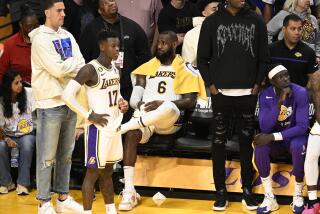TV Networks Lay It On as They Jockey for Ads
NEW YORK — At Manhattan’s famed Radio City Music Hall, home of the high-stepping Rockettes, NBC Entertainment President Jeffrey Zucker took a hard kick at his ratings rivals.
“We’re No. 1 in the morning, No. 1 in daytime, No. 1 in late night and No. 1 in prime time 47 of the last 56 weeks,” he boasted to a packed house of advertisers, agents and studio executives this week. “The momentum is all with us.”
But three days later, on Wednesday at historic Carnegie Hall, CBS was singing the same tune to the same crush of ad buyers and entertainment executives.
CBS not only has “television’s most watched drama,” network President Leslie Moonves told them, but also “the No. 1 family comedy,” “the No. 1 newsmagazine,” “the No. 1 movie night” and “the No. 1 daytime drama.”
Will the real No. 1 please stand up?
For the last four days in venues throughout midtown, the titans of TV have taken turns bashing one another and claiming ratings supremacy while unveiling their fall schedules during sometimes dazzling, star-studded extravaganzas to wow and woo advertisers. On the table is an estimated $7 billion for commercials.
Although the boasts and barbs fly every year, they were at their sharpest this time around. The competition between CBS and NBC is especially fierce. High numbers and good demographics can mean a shift of millions upon millions of dollars from one network to another in an advertising market offering new alternatives to broadcast TV.
The smart--and big--money usually goes to the network that can serve up the best audience. But this year during the network “upfronts,” where advertisers decide where they will place their bets, CBS and NBC both claimed victory, intensifying a feud that has been simmering behind the scenes for months.
In March, CBS quietly launched a counteroffensive with ratings firm Nielson Media Research to stop NBC from claiming in newspapers, trade publications and on the air that it was No. 1 in a slew of slots.
In fact, some of the NBC shows were the highest-rated among certain demographic groups prized by advertisers but did not have the largest overall audience.
Nielsen promptly instituted a policy that warned broadcasters not to make claims of being No. 1 or “most-watched” unless referring to total viewers or qualifying the boasts with footnotes.
“With research, you can really tell a lot of stories, and everyone of those stories can be accurate,” said Nielsen spokeswoman Karen Kratz. “Everyone can be No. 1 in a certain demographic group.”
Even limping ABC, once a ratings powerhouse, got into the act. Although the network has had only one show in the top 20 during the last year, “Monday Night Football,” executives noted during their Wednesday presentation in Broadway’s Amsterdam Theater that the show was No. 1 with male viewers.
Same with the fledgling WB Network, which did not have a show in the top 30 but claimed to be No. 1 with viewers between the ages 12 and 25 who are hooked on such dramas as “7th Heaven” and “Dawson’s Creek.”
Fox Broadcasting, meanwhile, had perhaps its own measure of viewership. John Nesvig, Fox’s president of sales, said the network was “No. 1 among English-speaking Hispanics ages 18 to 49.”
Reaching the broadest audience, in dollars and cents, is important. But increasingly, so too is finding the right audience: between the ages of 18 and 49 and earning at least $75,000 a year. Both CBS’ Moonves and NBC’s Zucker indelicately called them “quality” viewers.
“This is a business,” Zucker said in an interview, “and adults 18 to 49 is what matters. That’s what advertisers are buying on.”
One look at the teeming masses squeezed into the networks’ presentations made the point. Entrusted by their corporate clients to pick the most attractive shows for commercials, there were few gray hairs.
One of the fresh-faced attendees was 25-year-old Mark Kieblesz of Initiative Media North America in New York. A buyer for three years, he works on accounts for clients such as Arby’s, Gateway computers and Nextel. He and his clients understand their market.
“These advertisers know exactly what they want. Networks now really have to work for their dollars,” Kieblesz said.
Advertisers and their representatives say the networks’ overheated claims of ratings dominance are simply designed to whip up excitement or build a bandwagon effect around a show.
“We know the numbers, and we know that not everybody is No. 1,” said Bob Flood, a director and principal of Optimedia International in New York. His client list includes BMW, Whirlpool and New York Life Insurance.
“All of the networks,” he said, “have to play to their strengths.”
In some respects, the battle of the network executives goes beyond money. It’s about image and respect.
“This is a war of public perception,” said Gil Schwartz, CBS’ chief spokesman.
Perhaps there’d be no battling if there was more distance between NBC and CBS.
Overall, NBC has a 1-million viewer edge, thanks largely to its Winter Olympics coverage. It also has more young viewers with higher incomes, although CBS has made significant gains among that audience.
Of the top 20 shows, according to recent Nielson figures, NBC has 10 and CBS has nine. The other networks, ABC, WB, Fox and UPN, are far behind.
The sorest spots for CBS in the ratings brawl involves two programs that rank No. 1 in total viewership, the long-running daytime soap “The Young and the Restless” and the smash prime-time drama “CSI: Crime Scene Investigation,” which premiered this season.
NBC, in various promotional ads, said it held the No. 1 spot at night with the perennial drama “ER,” which scored highest with audiences between 18 and 49 but placed second in overall viewership.
“You could say you have the No.1 drama, but that could be among men who shop at Costco,” sniped David Poltrack, CBS’ executive vice president for research.
NBC makes no apologies, insisting that the demographic ranking of a program is far more important than the total number of TVs tuned to a show.
As Zucker put it, “If advertisers wanted to reach viewers who were wearing Depends, they would buy [ads] on “The Young and the Restless.”
More to Read
The biggest entertainment stories
Get our big stories about Hollywood, film, television, music, arts, culture and more right in your inbox as soon as they publish.
You may occasionally receive promotional content from the Los Angeles Times.











